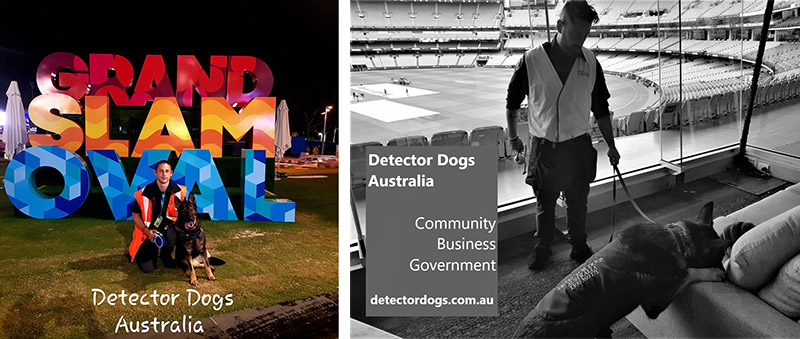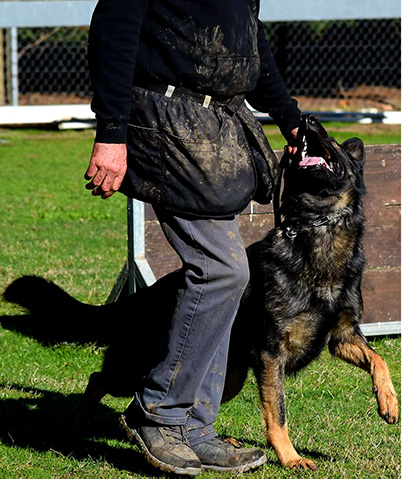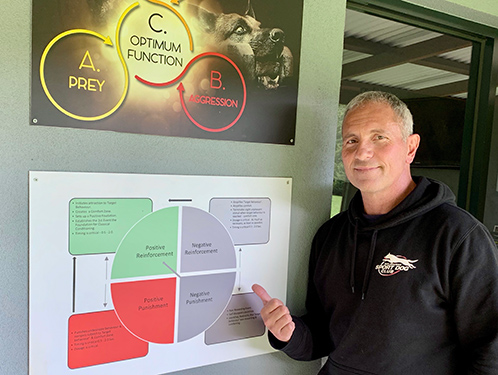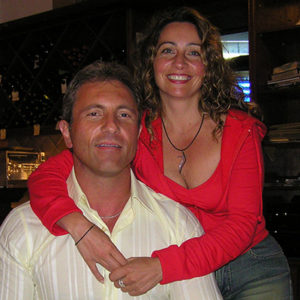
Kris Kotsopoulos (Von Forell Precision Training)
Kris Kotsopoulos’s story is a fascinating one. After their home was robbed, sixteen-year-old Kris had a natural and centuries-old reaction. He felt the family needed a dog around the place to deter would-be intruders. This landed him at Security Kennels owned by Neville Williams, a Dobermann and German Shepherd breeder in the early eighties. Serendipitously, this became a working relationship and friendship that is still going today. It became the first step on a journey that would take Kris around the world several times over, turn a passion into a livelihood and earn him global respect as a dog trainer of all dogs and breeder of German Shepherds and Dobermanns.
As a bit of background, the operations Kris and Neville have founded, and the science they’ve brought to the animal world have become woven into our everyday lives in a way in which, in so many cases, we, in the broader community, are unaware. Auditoriums and stadiums around the nation, for instance, are screened by working dogs trained and operated by their Detector Dog teams deployed by Detector Dogs Australia to pick up the presence of explosives before the doors are opened. Tracking, detection, obedience and protection are all skills in which working dogs contribute to the wellbeing and security in our modern society. Those dogs in service plus a vast number of pets owe their polished talents and calm demeanour to the breeding program and the intensive training systems developed by the team at Von Forell Kennels.

Detector dogs at work protecting us in so many ways were unaware of — at all levels of community, business and government.
Kris has orbited the globe over 20 times as a keynote speaker on genetics, animal psychology and training techniques. At the same time, he sought the definitive working-dog genetics, and he’s collected bloodlines from over a dozen different countries. The incorporation of these bloodlines has made the dogs bred at Von Forell amongst the finest strains of German Shepherds and Dobermanns to be found anywhere in the world. It’s taken him half a working lifetime, and his thirst for knowledge is far from quenched. As a matter of interest, they were the first kennel in Australia to commence DNA testing and genetic marking and were one of the first to store frozen semen from dogs that were to become the cornerstone of Von Forell’s reproductive excellence.
LifeWise caught up with Kris at his Pheasant Creek facility in Melbourne Australia. Driving up onto the ridge it was impossible to ignore the steepness of the jump-up and the skeletal remnants of the dense forest that clad the foothills before the horrendous Black Saturday bushfires that wrecked such a toll on life and property. As is often the case in such infernos, there are pockets that the demonically driven winds seem to overlook. The Von Forell Kennels and Training Facility had the miraculous good fortune to lie in one such haven.
Kris’s explained his genesis and his early years. “You can imagine coming home to find you’d been robbed and I thought we’d better have a deterrent dog. This event brought me to Security Kennels in Research, Melbourne. Upon the first visit, I became fascinated by training and then breeding; I became fascinated by what these dogs could do. From a behavioural point of view, I couldn’t for the life of me work out how these people got the responses they did, and it became a lifelong ambition to solve the riddle of obtaining reliable animal behaviour and addressing all the ugly variables”.
From that base, and considering his standing as a breeder and trainer, Kris’s answers to our questions on the subject were as informative as they were enthralling – even radical by some standards – but always firmly set in tried and tested scientific reality. His deep passion and understanding took us to places we’d not before been.
“In 1980, we became heavily involved in dog training. It grew exponentially because there was a huge market gap. I realised now the dog training community had the wrong idea of what a working dog was. We now know that quality animals are a particular type of animal, and that took forever to work out. A dog may have an instinct to herd sheep per se, but it has to be controlled through training to do it with verbal commands – with passion – and that’s tricky. The tricky part is that the dog wants to do something that it enjoys or is instinctive, and you, as a handler, want it to do the opposite, to stay in control. It took us a long time to work that out. It went on and on like that until the mid-1990s.

Working harmoniously under hardship with your dog develops a relationship. And it becomes a trusting, loving relationship.
“We’d had a lot of talented working dog people come out from Europe and the USA for training workshops and seminars. It was all a bit of trial and error, simply because the science wasn’t correctly implemented according to the learning laws. Interestingly enough, the science has been available since the early part of the 20th Century – Pavlov’s dogs – but we hadn’t worked out how to use that knowledge in dog training. In 1991, Dr Helmut Raiser came out from Germany. He’s considered the pioneer of modern dog training, especially protection training, which is nothing like the community perceives. He’s a dentist by profession, but his passion is animal behaviour in particular working-dog behaviour.
“From what we learnt from Dr Raiser, and many others, we established Australian Dog Training at six sites here in Melbourne. We took something we loved and were able to turn it into a commercial proposition while at the same time delivering positive outcomes to the clients and their animals.
“Protection dog training is a vastly misused term and doesn’t accurately describe what is going on. I prefer to describe the term ‘protection training’ as ‘drive satisfaction’ ‘drive fulfilment’ – training or ‘reinforcing instinctive behaviour to achieve drive fulfilment’. The term ‘protection training’ is a human-generated and culturally loaded term which has negative connotations. This term generates ambiguity in our community and confusion in the minds of many trainers; trainers who may not have had a great depth of experience and knowledge of animal psychology.
“Although the term ‘protection training’ seems to convey what appears to be transpiring in the public’s eye, the truth is, there is much more occurring than meets the eye. It’s really the strategic use of the learning quadrant and the shaping of naturally occurring instincts. The community believes ‘protection training’ results are achieved through agitating; antagonising and threatening dogs; and why wouldn’t they? These are the terms used in many writings in the past. The time has come to educate society that there is much more occurring and that what they see is not reality but their interpretation due to a lack of understanding.

Kris with the Von Forell intensive Training Method quadrant
“I often ask the questions, who is the dog protecting? You or itself? The truth is the dog is seeking reward, and we use those reward-seeking behaviours to perform a duty as humans would see it. The animal will always want to do what it wants: chase a rabbit, run across the road, play with the kids. The biggest obstacle to take note of is that you’re dealing with a 2-year-old delinquent. Two-year-olds are easily conflicted; therefore, dog training is simply the management of conflict. Due to this fact, the use of the learning quadrant is essential to create and sustain behaviour. Just like we have in society, there are consequences for every action. Pay your mortgage on time, every time, and all will run smoothly. To the dog, it’s simple, if I perform a specific action, I get a reward, and I will do more of it to keep getting rewarded. Then other behaviours don’t get rewarded, and as a consequence, they become less frequent and then non-existent. Effectively any negative learning should reorientate the dog back to what I call the target or desired behaviour.
But like that old Hank Williams song – Life Gets Tee-jus Don’t It – “It needs 80 to 130 repetitions in one location for the dog to even acknowledge that it understands something; before the light turns on so to speak. Then you need to repeat it in 15 different locations, so you disassociate the command from the location and generalise the behaviour. Working with a dog like this develops a relationship. And it becomes a trusting relationship”.
Kris has a view on the type of working dog many are breeding. “What I’d call a good dog is an animal that has intense behaviour traits, is self-confident, is exuberant, robust, doesn’t have emotional quirks, and is insensitive to the environment. Effectively, open and uncomplicated.
“This behaviour is usually associated with intense prey instinct – but those dogs require a higher skill level to manage. Far from impossible, but it involves some training commitment. Humans misunderstand those sorts of spirited dogs and as a consequence, label them as out of control. What they want is a dog, that sits in its corner when told and doesn’t move until told otherwise. So that’s the problem. What humanity has created, whether inadvertently or otherwise, is an animal that is sensitive to environmental stressors. That sensitivity makes them much more manageable, in a sense, because they also react to negativity too quickly rather than remain optimistic. These animals may be easier to control, but by breeding from them, we’re producing, what I call, behavioural volatility and an inability to deal with adverse situations that are part of the everyday world. The animal is generally sad and unstable, unsound and afraid of life. They may be manageable for us, but they’re not enjoying life as they should. I don’t believe this is fair for the animal. All the dog rescues centres in the world are inspiring and are a necessity for providing comfort, but they are not be able to provide the emotional stability the dogs deserve as that only comes from the dog’s genes.
“They’re being bred like that, and that’s not by design. The majority of the breeding I see is predicated purely by what we call emotional impulses. “I like that dog; it has beautiful eyes”. The stories I hear, like, “That dog will protect me against anything. His hair goes up, and he’s so tough”. In reality, that’s a frightened and fearful animal. But people breed from them.
“When you produce from these types of dogs, guess what happens? You tend to get more of the same types of dog, creating more of those unwanted and unnerving traits bred into the genes pool and then permeating throughout the globe because these beliefs are not solely isolated to Australia.
“Everyone’s entitled to treat their dog as a loving family pet. Every dog must be provided with a home and needs love and attention. But they should never be bred just for the convenience; they should be bred for function, and I am not simply referring to working dogs. Function to me means a dog that can operate as a sound animal in society and therefore not become a liability. The breeding should be left to people who know what a quality dog is. We’re all locked into our paradigm. We’re breeding the type of dog that sees the world as stressful. The idea would be to leave the breeding to those who can select the right dog and identify their positive traits that are an asset to the community. Those would include hardiness, a love of life and being unafraid of people, and certainly overall robustness. These are the dogs that socialise and interact with society amicably because they react to modern mans world favourably”.

Enforcement dogs are unique and require particular traits
Asked what he was finding as to the downstream result of this misconceived thinking in the breeding programs, Kris said, “If you’re looking at a competition dog or an enforcement dog, that is a unique dog. And that uniqueness comes from selecting for the above traits. To reach that level of excellence, you breed to a dog that carries these traits and then, through selective breeding and assessment, demonstrates its intrinsic quality in practical situations. With a distorted perception of what is desirable, it’s all too easy to breed to a dog that produces these distortions, therefore, reproducing the same – inadvertent as it may be – soft, sensitive and timid selection criteria down the line”.
While the argument as to when the dog became man’s best friend is ongoing, full domestication is believed to have occurred by at least 14,000 years ago; about the time we domesticated grains and livestock. With domestication came dependence and the domesticated wolf accepted society’s ways.
“The domestic dog and the wolf separated long ago and is far removed from the wild traits. The wolf hunts and chases to eat and survive. Although our domesticated dogs have a similar urge to chase, we have diverted that behaviour to create enjoyment for them and serve our purpose. When you throw a ball, your dog should chase it with vigour, and won’t want to give it up. If you try to wrench it from its mouth, it triggers a natural response; he clamps down harder on it, which is a natural and normal response in a quality dog. To him, ball-playing ultimately develops into a perpetually rewarding event – a game if you will. It’s so natural: that zest for life. But if they don’t have that part of their brain active, how do you make them happy? With food? This is a temporary high because the “hit” from food doesn’t last. The only time food works is when you have hunger as it is what provides the motivation to perform a task. As soon as saturation occurs – I wish you the best of luck motivating your dog to perform.
“If you want stability in the mind of your dog, life has to be enjoyable. That means a spirited dog, and it is being bred out of them in the name of compliance, it’s a sad situation, and there is no long-term win”.
Asked about the importance of mental stimulation as well as physical exercise, Kris said, “When a dog possesses the natural traits, they are easily stimulated into playing, this then produces the chemical dopamine in their brain which in turn becomes a rewarding event and an addictive state. With this worthwhile event, once established, it provides the handler with a powerful, rewarding mechanism. Now all you need to do is teach them an exercise with food so that they can concentrate and learn, and once it’s understood, then you can reward them with the ball as the ultimate reward. The fantastic thing is that a ball reward is so stimulating that they never get emotionally tired of it, and with some of them, it would seem that they don’t get physically tired either. The motivation to play is enormous. So, if this makes the dog happy what an excellent way to exercise them. While they are learning, they are playing, which means they love to learn, and it becomes addictive for you and them. We all know that if you love what you do, then you won’t stop doing it. Your job is to make sure that the dog understands what you want it to do. It then derives enormous enjoyment from it. Imagine an Olympian athlete doing what he/she hates; I would love to see their gold medal collection”.
Asked about the role food played in mental stability and physical development, Kris said, “Looking back on the foods in the ’80s and ’90s, I believe dogs were fed a non-nutritional diet. It’s as simple as that. In many cases, this prevails to the present day. What’s being offered to dog owners often falls short of a healthful, balanced ration. The animal likes it, but it’s not filling the nutritional requirements. This was the case until about 15 years ago.
“My story is that I was a huge natural feeder. Based on a French animal nutrition book and constant discussions by many, I’d been mixing my own feed and was pretty happy with the results. I continued down that path until a representative from Proplan came to see me. I told her I wasn’t interested, so she challenged me to raise one litter on their diet. Well, I have to say to you I was shocked. The difference was ridiculous. They were bigger, stronger, healthier, more robust, beautiful coats and bright-eyed. Then there was another thing; they were much more emotionally content, perhaps calmer is a better word. I said, holy hell. Let’s do it again. I repeated the feeding with five litters. The results were the same. Then the rep surprisingly said how about we sponsor you, which they did for six years. It was a partnership that worked. I steered quite a bit of business their way through the agencies and friends to which we were delivering dogs or training.
“Then there was a new rep, a new manager. They had obtained the market share they wanted, and they started making the food here in Australia, not importing it from the US. Within a year they’d lost the market share they’d built on the American formula. Dogs were scouring, losing condition, losing concentration. And that’s what propelled me to start my food brand, Performadog and we also have cat food called iPurr. I’d always wanted to go down the production of pet nutrition, but time, capital and most importantly, knowledge were an issue. When I first started getting our food made by Australian Pet Brands, the formula was pretty good; the results were not dissimilar to what I’d got before. I wanted to change some configurations with the food, based on some advice from a Vet. They were reluctant to make the necessary adjustments, and it was then that we found out that they’d sold the company. So, once again, a supplier that hadn’t been transparent, and the last thing I wanted was the efficacy of the food dropping off. Bill Wiadrowski of Natural Balance is our nutritionist now, and we couldn’t be happier.
“He’s provided us with a puppy formula that ensures good health outcomes from those crucial early stages when bone and muscle development, as well as mental capacity, is laid down. It’s so important to get them off to a good start if you’ve got any hope of developing their full physical, genetic potential. He’s also designed a fish and turkey-based formula that helps all dogs and our working dogs. Working dogs are under a lot of physical stress, and the diet is working well.

Dynamic duo: Kris with his wife Tonia
“We originally started Performadog and iPurr for a boutique market. My training partners have benefitted from the formula and, through my working relationships and friendships, I’m more aware that many in the dog world are interested in the vital role nutrition plays in animal wellbeing and development. Over the last 12 months, I’ve been making sure that the food we’re offering, by any scrutiny, by any analytics, will come out tops and that it covers every facet of the animal’s needs”.
Our website has been designed to help all pet lovers develop an accurate and in-depth understanding in animal nutrition, and I have added what Tonia my wife, and I do on a personal level that may help our pets’ best friends, their handlers. I have interviewed Bill on the website in an attempt to answer all questions frequently asked by our clients. Every ingredient is listed and addresses the nutritional impact on the body.
We also asked Kris about his breeding;
The number of litters reared a year at Von Forell can vary significantly, and the animals are mostly pre-ordered before whelping. Eighty per cent will go to people who want a healthy, stable companion. Kris again, “We breed to the highest standard possible, which results in an evenness, but three or four will excel. These go to people who are looking for that “special” dog for the Championships or in Agencies. These dogs need and deserve extra professionalism in their lives”.
To ensure that their detector dogs and their training methods were up to world standard Kris and Neville sought International assistance from US Authorities providing external auditing by the North American Police Dog Association. Needless to say, they passed with flying colours.
There’s no doubting the absolute depth of the knowledge and experience embedded at Von Forell and Detector Dogs Australia. And there’s no overestimating Kris Kotsopoulos’s passion for breeding and training working dogs that will be well-adjusted and valuable members of the community. He’ll be quick to tell you how he’s been lucky to be able to turn a passion into a livelihood, but he never mentions the hard work, the patience, and the setbacks that have got him, his family and partners where they are today.
Currently, Kris’s interest lay with his Team members at the Melbourne Sport Dog Club who he says has made him very proud.
Kris can be contacted by email at [email protected] or by phone on 0418 348 804.
Please visit his websites.
